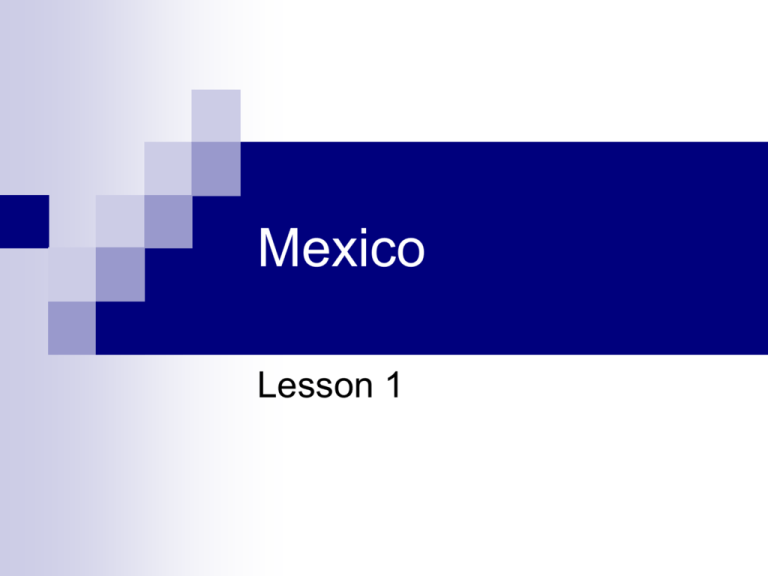Mexico
advertisement

Mexico Lesson 1 Do Now Mexico Geography Essential Questions 1) What are the physical and political features of Mexico? 2) How have the people of Mexico adapted to its climate and vegetation? Lesson #1 Vocabulary Define the vocabulary: Vocabulary isthmus Peninsula Tierra caliente Tierra templada Tierra fria Frost plateau sierra Isthmus A small strip of land, with water on both sides that connects two larger areas of land. Peninsula A Piece of land that is mostly surrounded by water. Tierra Caliente A climate term used in Mexico meaning “hot land”. Tierra templada A climate term used in Mexico meaning “temperate land”. Tierra fria A climate term used in Mexico meaning “cold land”. frost A covering of tiny ice crystals that form on a surface when dew or water vapor freezes Sierra A chain of mountains whose peaks look like the edge of a saw. Plateau A high, flat area of land What are the physical and political features of Mexico? (p. 172-174) LANDFORMS (10) CLIMATE (3) BODIES OF WATER (6) CITIES (11) Don’t Do These BORDERS(3) OTHER INTERESTING FACTS (3) LANDFORMS (10) Isthmus of Tehuantepec Baja California Plateau of Mexico Sierra Madre Occidental Sierra Madre Oriental Sierra Madre del Sur Popocatepetl Senora Desert Yucatán Peninsula Rain Forest Beaches Islands BODIES OF WATER (6) Rio Grande (Rio Bravo del Norte) Pacific Ocean Gulf of Mexico Gulf of California Caribbean Sea Bay of Campeche CITIES (11) Mexico City Guadalajara Tijuana Mexicali Ciudad Juarez Monterrey * Cancun * Acapulco * Puebla *Veracruz BORDERS(3) United States Belize Guatemala Interesting Facts Mexico has 31 states. Cancun is a tourist spot. Volcanoes start in Mexico because the movement of tectonic plates. What are the physical and political features of Mexico? LANDFORMS (10) BODIES OF WATER (6) CLIMATE (3 DESCRIBE) CITIES (11) Isthmus of Tehuantepec Baja California Plateau of Mexico Sierra Madre Occidental Sierra Madre Oriental Sierra Madre del Sur Popocatepetl Senora Desert Yucatán Peninsula Rain Forest BORDERS(3) United States Belize Guatemala Rio Grande (Rio Grande del Norte) Pacific Ocean Gulf of Mexico Gulf of California Caribbean Sea Bay of Campeche Mexico City Guadalajara Tijuana Mexicali Ciudad Juarez Monterrey * Cancun * Acapulco * Puebla *Veracruz OTHER INTERESTING FACTS (3) Answers will vary Do Now Mexico’s Climate What are the different climate zones in Mexico? Read pages 175-176. Complete the main idea chart for Mexico with a partner. tierra caliente Hot land Elevation sea level to 3,000 feet Hot summers Mild winters No frost tierra templada Temperate land Elevations between 3,000 and 6,000 feet Average temperature is between 80F and 50F. Most of Mexico’s farms are in this area. Most of its people live in this zone. tierra fria Cold land Elevation above 6,000 feet Temperatures are not real cold or real hot. Frost is unusual in areas below 8,000 feet. The highest mountains peak are colder and covered with snow all year-round. On the last page (back) in your notebook: Summarization Activity Ticket out the door Explain the major climate zones in Mexico. Give at least 2 details for each type of climate zone. Write this in paragraph form. The three major climate zones in Mexico are Summarization Activity Dear Mr. Fisher Letter: Tell me what important facts you know about the geography of Mexico. Be as specific as you can be.



